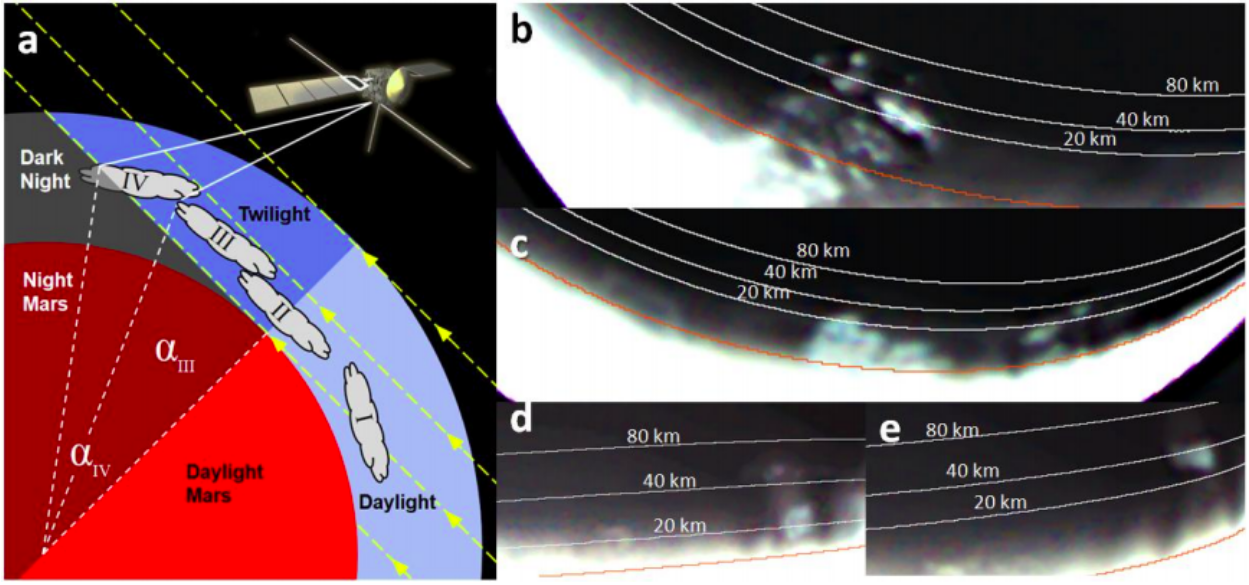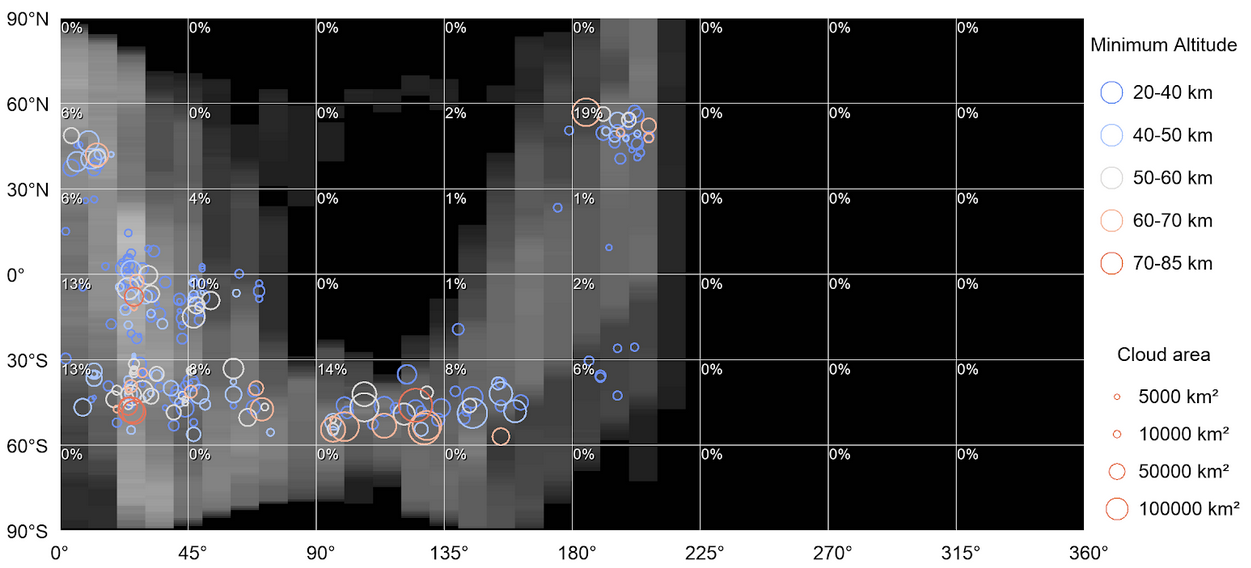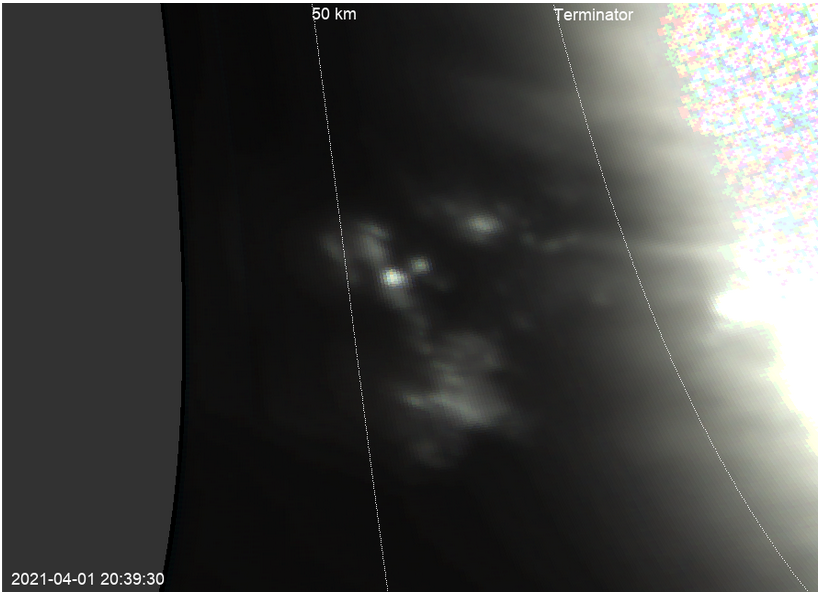Cloud tracking and dynamics of Martian mesospheric clouds in twilight as seen by MEX/VMC
- 1Departamento de Física Aplicada. Escuela de Ingeniería de Bilbao. UPV/EHU
- 2European Space Astronomy Center (ESAC). Agencia Espacial Europea (ESA).
The Visual Monitoring Camera (VMC) on Mars Express (MEX) has the capability to capture full disk images of Mars from apocenters. This has allowed us to compile a large archive of images showing Mars at different local times, including the twilight region beyond the day side terminator. The observation of clouds in twilight enables the estimation of their “minimum altitude”, as they must be high enough over the surface to be illuminated by the sun and appear as bright patches over the darkness of the night.
A systematic study of clouds seen in twilight was made by Hernández-Bernal et al. (2021b). This work extends the analysis, increasing the dataset and focusing on dynamics. VMC has the rare capability to obtain videos showing atmospheric dynamics (e.g. supporting material in Hernández-Bernal et al., 2021a) and we exploit this capability to estimate the accurate altitude of clouds, perform cloud tracking, and analyze their cloud dynamics.

Figure 1. Reproduced from Hernández-Bernal et al. (2021b). (a) Scheme of observation of clouds in twilight. (b-e) examples of clouds in twilight observed by VMC. See original paper for full description.
We run the automated cloud detector pipeline developed by Hernández-Bernal et al. (2021b), to include most recent observations into our dataset. Most recent observations in MY36 reproduce previously reported patterns in the distribution of mesospheric clouds in twilight (Figure 2), and the extended coverage hints the presence of more clouds in twilight than previously observed, at the starting of the year in the southern mid-latitudes, and in the northern mid-latitudes at the starting of the local autumn.

Figure 2. Recent observations of clouds in twilight found by VMC in MY36. The horizontal axis represents the Solar Longitude (Ls). See the equivalent graph for the whole dataset in Hernández-Bernal et al. (2021b)
We use this extended dataset of clouds in twilight observed by VMC to feed a newly developed pipeline that creates videos showing the dynamics of such clouds. This new pipeline outputs around 500 videos. All these videos are manually analyzed and cloud tracking is performed when possible. Less than 100 videos exhibit a good quality and show clouds that are suitable for cloud tracking. We compare our cloud tracking to expected winds as given by the Mars Climate Database (MCD; Millour et al., 2015).
The results of this work are expected to be a valuable dataset, as it involves the direct measurement of winds at specific altitudes, very often in the mesosphere of Mars. Määttänen et al. (2010) also measured winds on Martian mesospheric clouds based on the stereo capabilities of HRSC (High Resolution Stereo Camera) onboard Mars Express.

Figure 3. An example of clouds seen in twilight by VMC. This is a projected image that is part of a long observation from which a video was made. White curves indicate the terminator, and the limit where clouds below 50km cannot receive the illumination of the sun and therefore will not be visible. The accurate altitude of clouds can be estimated from videos showing clouds appearing in the night side of the terminator. An animated version of this image can be found in https://figshare.com/articles/media/Twilight_video_example/19772797
References
Hernández‐Bernal, J., Sánchez‐Lavega, A., del Río‐Gaztelurrutia, T., Ravanis, E., Cardesín‐Moinelo, A., Connour, K., ... & Hauber, E. (2021). An Extremely Elongated Cloud over Arsia Mons Volcano on Mars: I. Life Cycle. Journal of Geophysical Research: Planets, 126(3), e2020JE006517.
Hernández‐Bernal, J., Sánchez‐Lavega, A., del Río‐Gaztelurrutia, T., Hueso, R., Ravanis, E., Cardesín‐Moinelo, A., ... & Titov, D. (2021). A Long‐Term Study of Mars Mesospheric Clouds Seen at Twilight Based on Mars Express VMC Images. Geophysical Research Letters, 48(7), e2020GL092188.
Määttänen, A., Montmessin, F., Gondet, B., Scholten, F., Hoffmann, H., González-Galindo, F., ... & Bertaux, J. L. (2010). Mapping the mesospheric CO2 clouds on Mars: MEx/OMEGA and MEx/HRSC observations and challenges for atmospheric models. Icarus, 209(2), 452-469.
Millour, E., Forget, F., Spiga, A., Navarro, T., Madeleine, J. B., Montabone, L., & Lopez-Valverde, M. A. (2015, September). The Mars climate database (MCD version 5.2). In European Planetary Science Congress (Vol. 10).
How to cite: Hernández-Bernal´, J., Sánchez Lavega, A., del Río Gaztelurrutia, T., Hueso Alonso, R., and Cardesín Moinelo, A.: Cloud tracking and dynamics of Martian mesospheric clouds in twilight as seen by MEX/VMC, Europlanet Science Congress 2022, Granada, Spain, 18–23 Sep 2022, EPSC2022-456, https://doi.org/10.5194/epsc2022-456, 2022.

